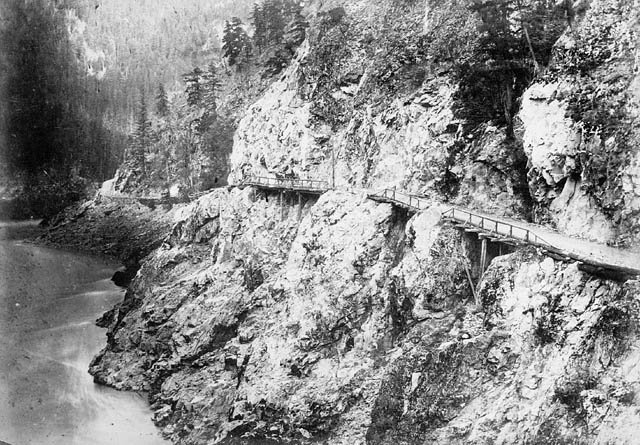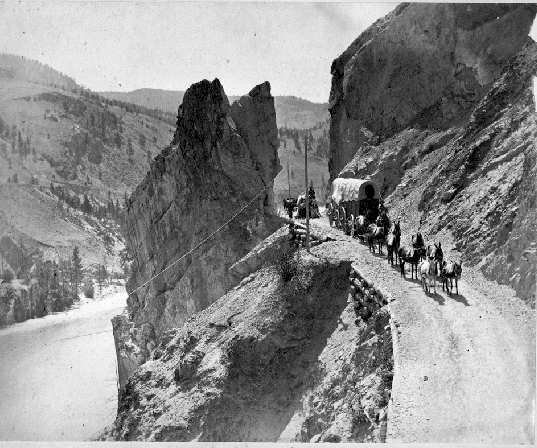Packing for a Trip up the Cariboo Road
British Columbia has known a series of gold rushes in rapid succession, the first being the Haida Gwaii Gold Rush in 1851 and the last being the Klondike Gold Rush from 1896-1899. BC quickly gained the nickname “The New Eldorado”, but alas, it was far from being a golden paradise as this legend would have it. These gold rushes brought many settlers into unknown territory in hopes of finding a few nuggets of precious gold. The Cariboo Gold Rush (1859) took place in the interior of what is colonially known as the Cariboo region, on the traditional and unceded territories of the Nlaka’pamux, the St’atl’imx, the Secwepemc, The Tsilqot’in, and the Dakelhne peoples.
The miners during the Cariboo Gold Rush would use the Cariboo Road to get to the gold fields. Construction on the road didn’t start until 1862 and was completed only in 1865, at the tail end of the gold rush. This road connected Fort Yale to Barkerville, covering a vast distance of about 650km. This was received with open arms as prior to this there were a limited number of roads in central British Columbia and the mountain regions made the landscape particularly difficult. Before and during this period the only alternate roads were a few smaller trails – most made by Indigenous peoples – through the woods. However, these were steep, narrow, winding mountain trails and could be hard to find. People would also travel on the Fraser River – which ran parallel to the Cariboo Road – by canoe or by paddle wheeler, which was marginally safer than trying to make it on your own, especially because of the rapids.
Most of the miners were single white men in their 20s, eager to make a fortune. However, it is said that British Columbia back in 1858 was as culturally diverse as it is now. There were also Black, South American, Mexican, and Chinese miners. There was already a sizable Chinese population in British Columbia because of other gold rushes and work opportunities. Like the white settlers, they were mostly single men, their families having stayed back in China. They had very strong communities and created an economic boost for the province, as most of those who did not get lucky mining became business owners. These businesses would serve the miners in small towns like Barkerville and Quesnel as grocery stores, laundries, and restaurants.
There were also many Indigenous peoples involved in the gold rushes. While the Indigenous peoples had an uneasy relationship with the settlers, as the settlers were stealing their land, they were usually the first to find gold and provide accounts. They also often took up the vital role of “packer.” Packers would usually pack and help carry the miner’s supplies, equipment, and provisions. This would all be carried on a packboard or in a packsack and could weigh up to 60-70 pounds, and sometimes even up to 100 pounds. As opposed to the white miners, who would hire these packers, Chinese miners would usually carry their belongings themselves on a pole across their shoulders. On one end they carried blankets, clothing, and mining equipment, on the other were provisions.
Here are a few basics miners were advised to bring with them on their arduous journey:
A strong waterproof coat
Two thick blue flannel shirts
A warm pea jacket
Waistcoat and trousers to match
A light drill or fustian jacket and trousers
A pilot overcoat
A pair of strong leather braces
Three pairs stout worsted stockings or socks
Three pairs cotton stockings or socks
Six pocket handkerchiefs
One pair boots
Highwater boots
Six strong loose cotton shirts
Strong felt hat
Light soft hat
Three towels
Shaving glass, brush and razor
Hairbrush and comb
Two pounds marine soap
2 blankets
One sheet
A hair bed or mattress and pillow
Blacking and brushes
A knife and fork
A pint drinking mug
Tin bowl and can
One tin plate
A tablespoon and teaspoon
A hook pot
Miners were then advised to take the following to the gold fields:
A miner’s licence
A gold pan
A good quality axe
A miner’s pick
A round-nosed shovel
Tall, sturdy rubber boots
A packboard/packsack
A small bottle to store gold
Matches, compass and a strong weatherproof container for them
An area map and notebook
Curved tweezers for taking gold from the pan or cracks in bedrock (optional)
A stiff whisk for brushing bedrock dirt in pan (optional)
A small magnet
A good sleeping bag/double blanket
A tent or 7x8 canvas sheet
Aluminum or tin cooking pot, enamel cup
Soap, bandages, iodine, simple medicine
As these lists suggest, the miners needed to be prepared for the rough climate of British Columbia. Winters sometimes made it so they sometimes worked in “snow so deep that horses could not travel.” The gold rush brought over 30,000 new arrivals to the province and miners could easily get lost in the crowd, especially since this was uncharted territory. Men could collapse and get attacked by bears. Once a miner found their way though, conditions did not get much better. The cost of living in goldfields was high and food was sometimes hard to find. At Fort Yale, you could only purchase blankets and beans. Food was about 25% more expensive to buy in the Cariboo region than in cities like Victoria (flour was $60 a barrel versus $15 in larger cities). They could buy this food in Victoria, but the cost of carrying goods on the train was high. This caused much suffering and starvation in the fields and on the trail. Other supplies had to be imported as well, which cost the miners a lot since transportation for them could cost about a dollar per pound. The miners were also constantly hounded by flies and mosquitoes. They were extremely irritating and drove many miners to madness.
Once the Cariboo Road neared completion, living conditions got much better. There was now a clear and safe path up north, not only for miners, but for settlers and freight as well. The town of Ashcroft became a transportation centre where trains and stagecoaches could stop and replenish supplies. Mule and ox-driven wagons were the main means of freight up the Cariboo Road. Food prices started dropping to a reasonable level again and while miners still ventured off to try to make a fortune, they also had more time to marry and settle down. While the life of a miner trying to strike it rich was still difficult, a completed road at least made the journey a little easier.



